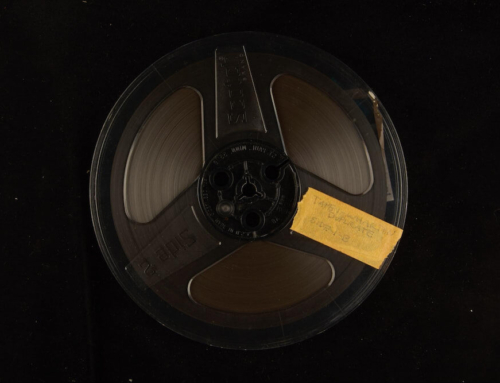This spring we opened our doors with Movement is Life, an exhibition exploring the influence of modernist dance communities on Esherick’s creative trajectory, on view in our Visitor Center through June 2, 2024. Throughout the 1920s and into the 1930s, Esherick traveled to dance camps with his family – in particular the Ruth Doing School of Rhythmics, later renamed the Gardner-Doing Camp for Rhythmics – in the Adirondacks. The ethos of the camp, which centered around connecting with the natural rhythms of the world, is one that left its mark on Esherick as he observed, danced, painted, and sketched over summers spent within these communities. Esherick’s involvement with these camps also provided him with early opportunities to explore furniture making, often in the form of large, purpose-built tables.


Wharton Esherick, Camp Tables, Pine, ca. 1925. Wharton Esherick Museum Collection.
Two large pine trestle tables in the WEM collection offer examples of these early explorations. Still relatively new to woodworking, one can imagine Esherick eager for an outlet for his furniture designs. Esherick was known to exchange his creative skill for tuition for his family’s cultural endeavors. He famously traded hammer handle chairs to the Hedgerow Theatre for his daughter’s apprenticeship there, and paid his daughter Mary’s tuition at the progressive Hessian Hills School in his chairs of the same name. It is likely that a similar exchange was worked out for at least part of the dance camp’s expense through furniture as well as prints for the camp brochures. The two camp tables offer subtle cues to Esherick’s developing design sense, featuring inviting and tactile rounded edges, hefty trestles on each end, and a long low stretcher, though their functional purpose seems to have dominated the final form. These tables provided ample space for attendees to gather and enjoy meals at a form in tune with the pine forests that surrounded them.
This drawing depicts children at the camp, at what is likely an Esherick trestle table.
Wharton Esherick, Dance Camp, Crayon on paper, 1929. Wharton Esherick Museum Collection.
Gail Gardner and Ruth Doing, who ran the camp together, considered dance and movement part of a harmonious and balanced life, with diet, music, crafts, and other activities interwoven with the camp’s mission. One activity at the camp involved a drawing exercise set to music – where dancers interpreted what they heard into visual flowing and abstracted form. On the Ruth Doing’s Trestle Table with Carvings, a large table commissioned for the camp which is now in the collection of the Threefold Educational Foundation, Esherick used these designs in a carved motif around the border of the tabletop. The final result is a truly unique collaboration between Esherick and other attendees to the camp that embodies the influence and entanglement these communities held within Esherick’s creative explorations.




Wharton Esherick and Others. Ruth Doing’s Trestle Table with Carvings, oak, ca. 1923. Threefold Educational Foundation Collection. Images courtesy of Threefold Educational Foundation.
Much about this table is still a mystery. It is believed that Esherick carved the four corner designs with the other campers carving their drawings into the wood themselves. The project was never completed, and so the tabletop as seen today offers a visual rhythm of rests and beats – a project in motion, open-ended rather than static. There is some question as to whether Esherick participated in the building of the table. A sketch by Esherick from our works on paper collection appears to be of this, or a similar table, designed for the camp. On the sketch, dated 1923, Esherick attributes Mason & Son, a carpenter in Plattsburg, NY, as constructing the table to his design. Esherick also makes note that they, “Leave plenty of material tenons and wedges ends A & B for carving.”
These sketches from the WEM works on paper collection were inspired by music and drawn by Esherick and fellow students, ca. 1923.

Wharton Esherick, design sketch for a trestle table for the dance camp, 1923. Wharton Esherick Museum Collection.
The table is now on view in the library of the Threefold Educational Foundation. Founded in 1926, Threefold offers a wide array of programs and community engagement rooted in anthroposophy. Among the initial members of Threefold was Louise Bybee, a dear friend of Wharton and Letty Esherick who was also deeply involved in the dance camps. It is likely through Bybee that the table made its way to Threefold.
We are excited to revitalize the Esherick connection to Threefold with our upcoming program Dancing with Esherick: Eurythmy Workshop and Exhibition Talk on April 27th. For this two-part program we are delighted to be joined by Sea-Anna Vasilas from Threefold who will lead a introductory eurythmy workshop in the 1956 Workshop followed by a talk by WEM Director of Interpretation & Associate Curator of Special Collections Holly Gore on the museum’s spring exhibition, Movement is Life, and the influence of modern dance as a catalyst for creating rhythmic art that is expressed in some of Esherick’s earliest wood carvings.
Join us on April 27th and deepen your understanding of Esherick’s practice by exploring the movements and natural rhythms that resonated throughout his creative life
Post written by Katie Wynne, Deputy Director of Operations and Public Engagement
March 2024







